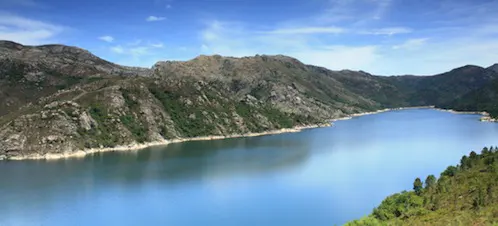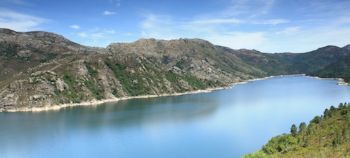The Vinho Verde region is located in the northwest of Portugal, with the Minho river as its limits to the north, the Douro river to the south and the mountains of Peneda, Gerês, Cabreira and Marão to the east, and the Atlantic Ocean to the west. Region demarcated on September 18, 1908, is the largest Portuguese demarcated area and one of the largest in Europe. It represents 15% of the total national wine-growing area.

Image: vinhoverde.pt
Sub-Regions of the Vinho Verde Wine Region
The Vinho Verde region is divided into 9 sub-regions:
- Amarante: located inland, the sub-region of Amarante is protected from the influence of the Atlantic and at a high average altitude, which means that the temperature ranges are higher than the average for the region, and the summer is warmer. The soil is granitic. White wines usually have fruity aromas, however it is from the red wines that this sub-region is famous.
- Ave: the vine is planted all over the hydrographic basin of the river Ave, in an area of irregular relief, which makes it exposed to sea winds. The climate is characterized by low thermal amplitudes and average precipitation indices. This sub-region is known above all for producing white wines with lively freshness and floral and citrus fruit notes.
- Baião: located in the interior of the Vinho Verde region, at an intermediate altitude. These conditions create a less temperate climate, with a colder, less rainy winter and a hotter, drier summer. This sub-region is famous for the production of white wines of great notoriety.
- Basto: it is the innermost sub-region of the Vinho Verde region, lying at a high average altitude. The climate in winter is cold and very rainy and in summer it is very hot and dry, favoring late maturing varieties. There is also a production of red Vinhos Verdes that have a full and fresh mouth.
- Cávado: the vineyard in this sub-region is located throughout the river's hydrographic basin, being highly exposed to low-altitude and maritime winds. This means that there is a mild climate, without large thermal amplitudes. This type of climate is ideal for producing white wines. They are wines with moderate acidity and notes of citrus fruits, ripe apple and pear.
- Lima: it is here that precipitation reaches its highest values. The altitude at which the vine is planted varies and increases from the coast to the interior, where the relief is also more irregular. In addition to the granitic soils, there is a strip of schist soils. The most famous white wines in this sub-region are produced from the Loureiro variety.
- Monção e Melgaço: it has a very particular microclimate, with cold winters and hot, dry summers. The soils are mainly of granitic origin. It produces exclusively the Alvarinho and Pedral varieties.
- Paiva: it is not one of the sub-regions with the highest precipitation index, for this reason the Amaral and Vinhão grape varieties manage to reach optimal stages of maturation and produce some of the best wines in the entire region.
- Sousa: the main varieties are the most typical of the mild places: Arinto, Loureiro and Trajadura, to which Azal and Avesso are added, which have a more demanding maturation.
Types of wine and grape varieties from the Vinho Verde Wine Region
The main grape varieties in this region are white: Alvarinho, Arinto, Avesso, Azal, Loureiro and Trajadura. However, three red varieties are also planted: Espadeiro, Padeiro and Vinhão.
Vinhos Verdes can be further classified into several types:
- Young and White Vinho Verde: they have a citrus color, rich, fruity and floral aromas, depending on the grape varieties from which they originate. In the mouth they are harmonious, intense and have a great freshness.
- Aged Vinho Verde: they have a golden color, with more ripe fruit aromas such as quince and honey. They have complexity and structure.
- Rosé Vinho Verde: they have a light pink color, young, fresh aromas reminiscent of red fruits. The flavor is harmonious, fresh and persistent.
- Red Vinho Verde: they have an intense red color, with an emphasis on wild berries. In the mouth they are fresh and intense.
- Sparkling Vinho Verde: they have a strong taste complexity and an aromatic freshness.
Terroir of the Vinho Verde Wine Region
Vinho Verde is the largest DOC in Portugal. The climate varies considerably across the region, which is reflected in the nine sub-regions already mentioned. It has an Atlantic influence, reinforced by the orientation of the valleys of the main rivers that facilitate the entry of maritime winds. But some sub-regions, because of the microclimate, have distinct terroir characteristics, which directly influence the wine.
The vines grow in fertile granite soils along rivers.

Image: Wine Tourism in Portugal
Harmonization of Vinho Verde with food
When it comes to light and fresh Vinho Verde, the ideal is to be paired with a summer salad of melon or shrimp, cheese crackers or sushi.
The intense and fragrant ones, from the Avesso or Loureiro varieties, go well with dishes with aromatic ingredients and spices, such as chicken breast with mushroom cream sauce, or pumpkin risotto with roasted shrimp.
Complex and structured wines, such as those from the Alvarinho variety, go very well with lobster au gratin, veal chops or roasted quail.
Stronger red wines, on the other hand, combine well with regional cuisine, such as grilled sardines, rojões, among others.
 Portugal
Portugal Spain
Spain France
France Germany
Germany United Kingdom
United Kingdom Monaco
Monaco



